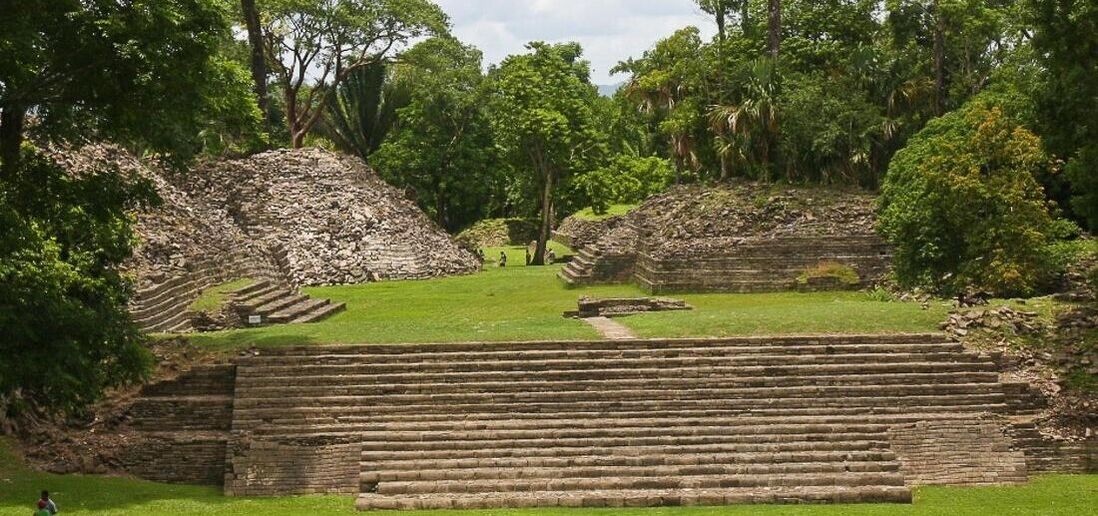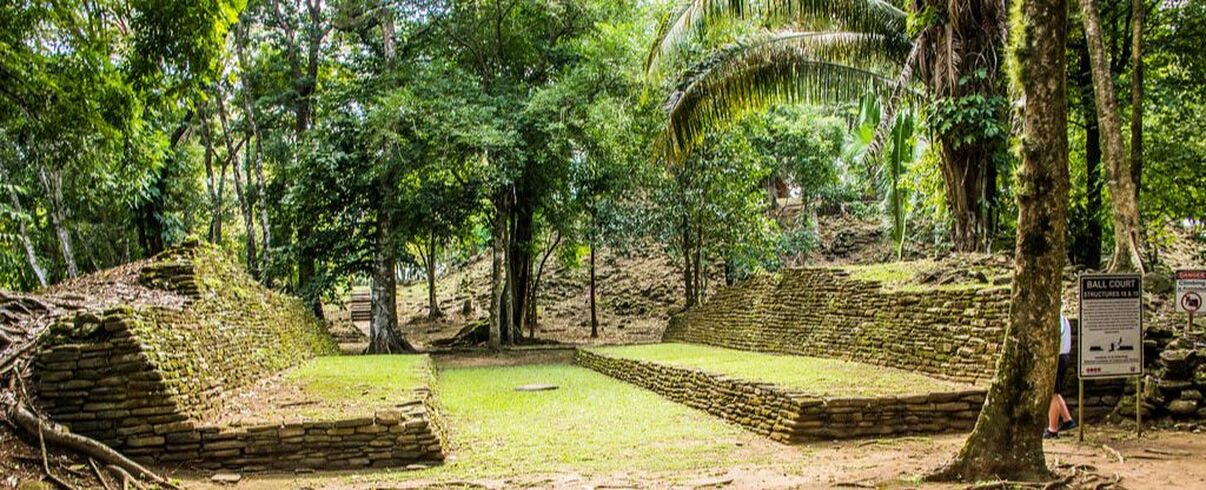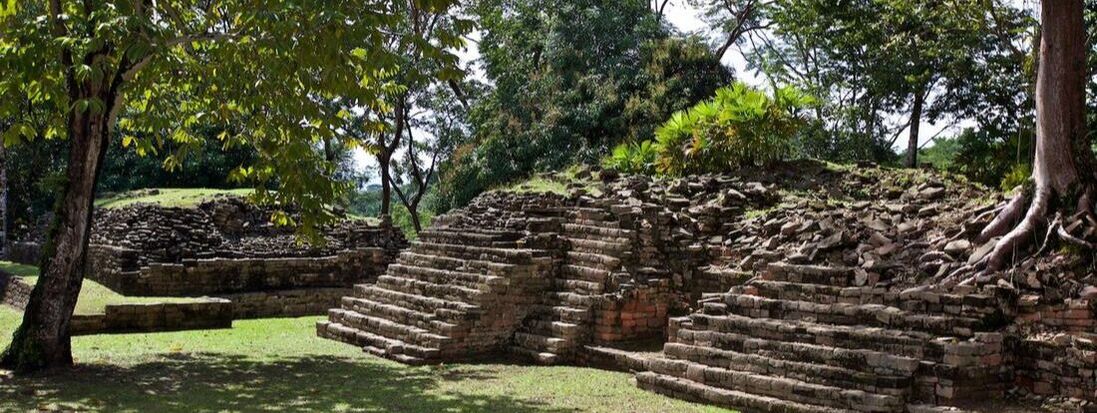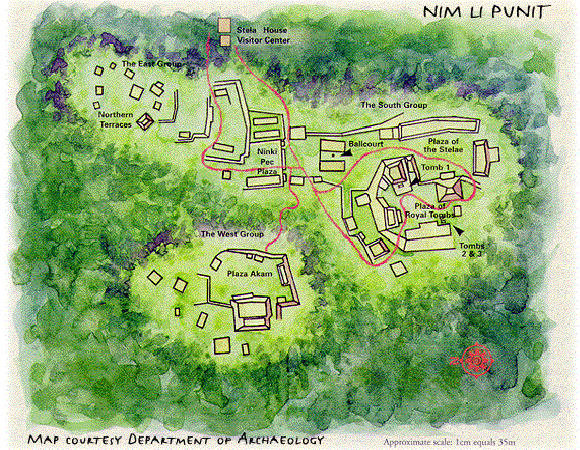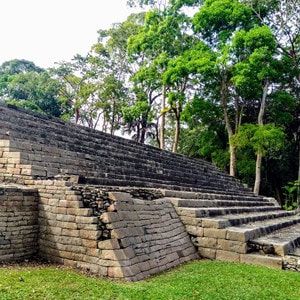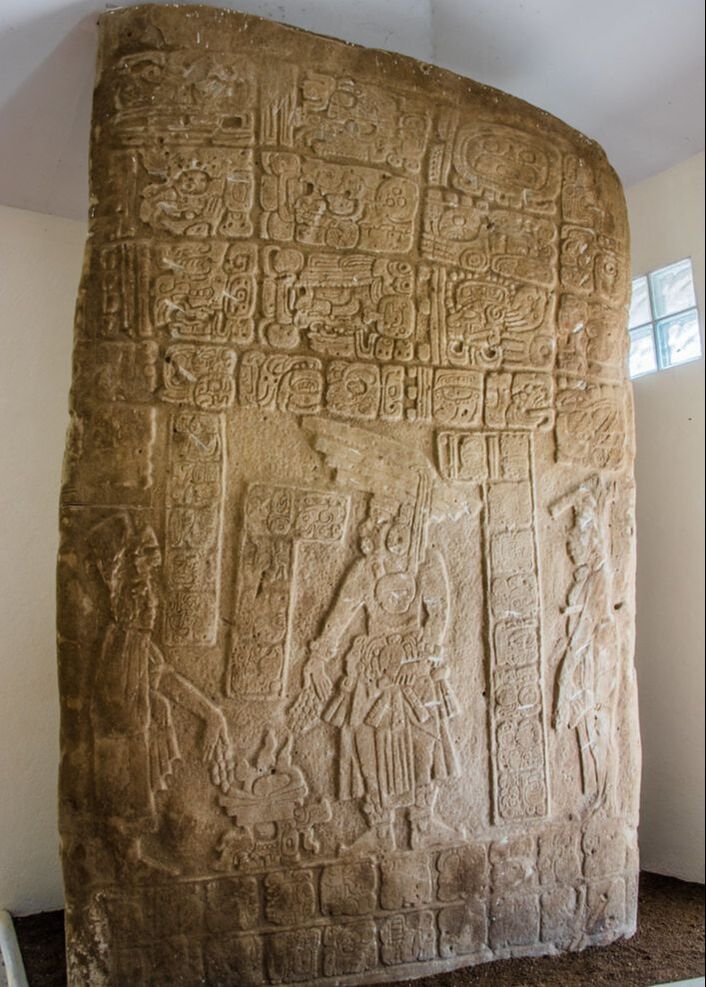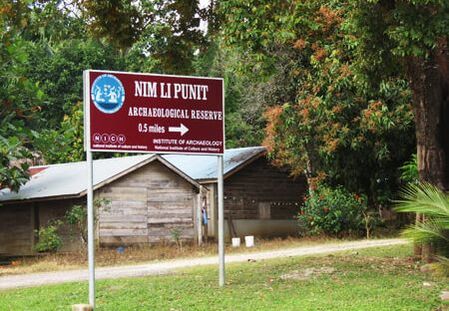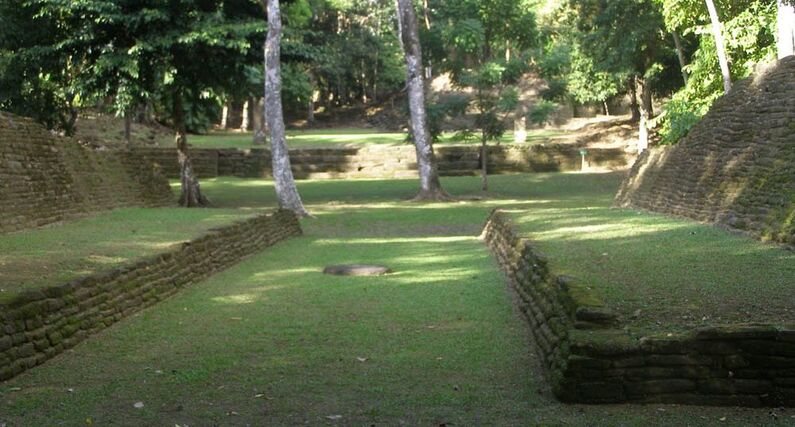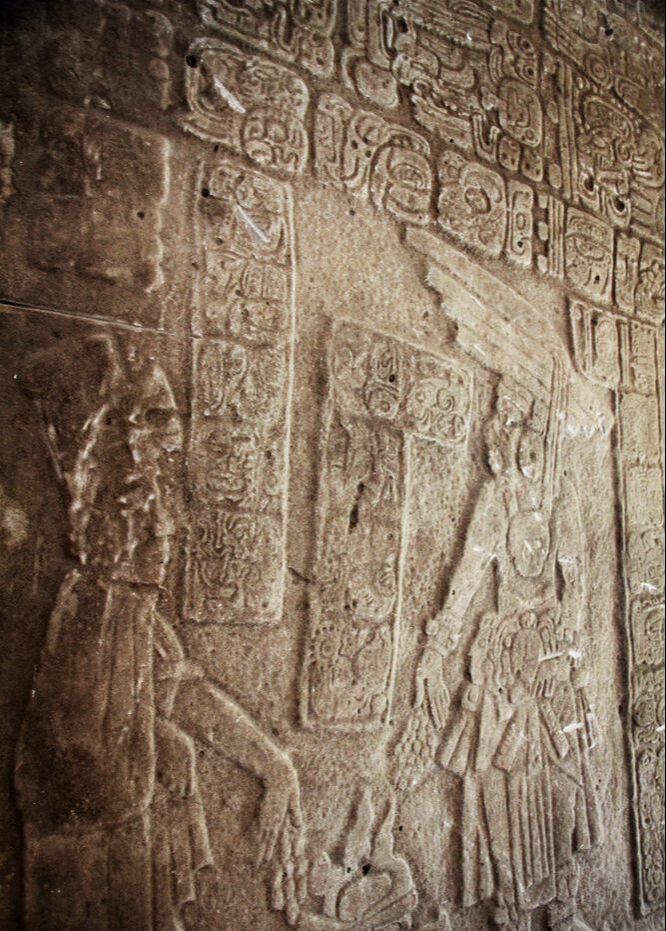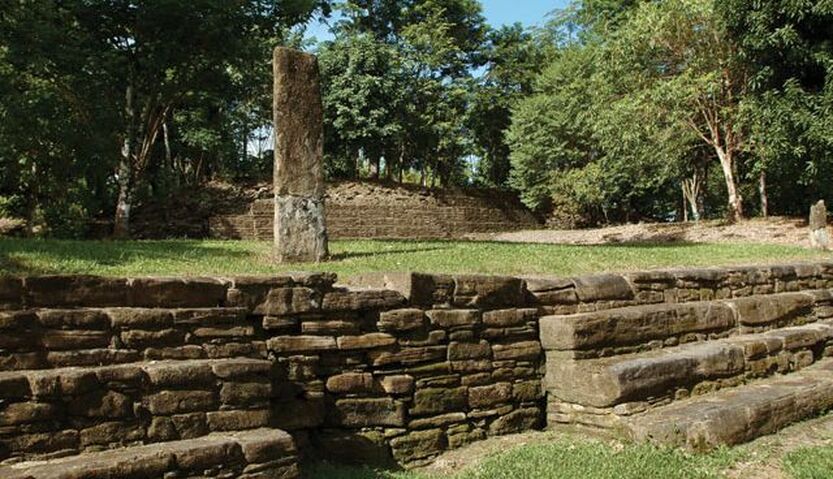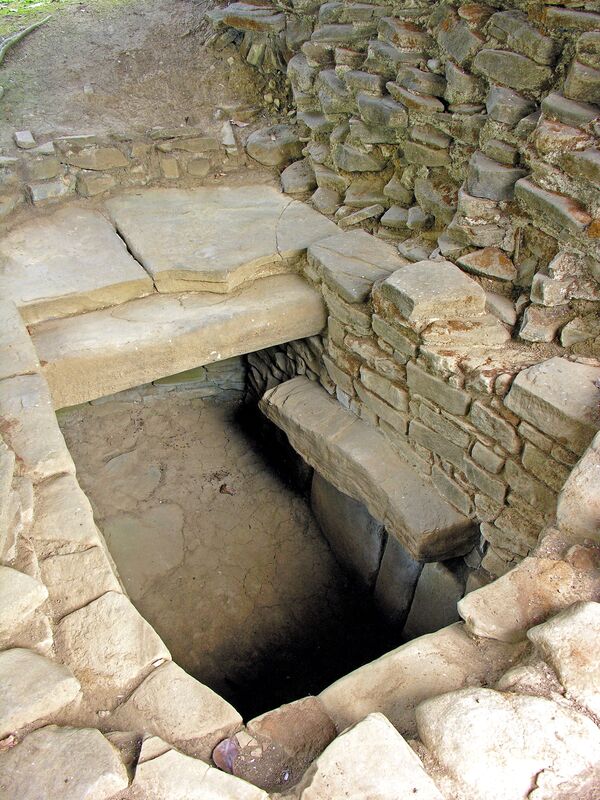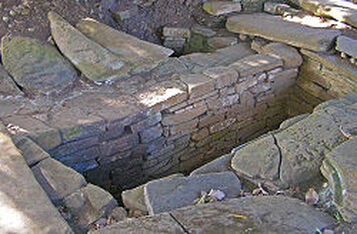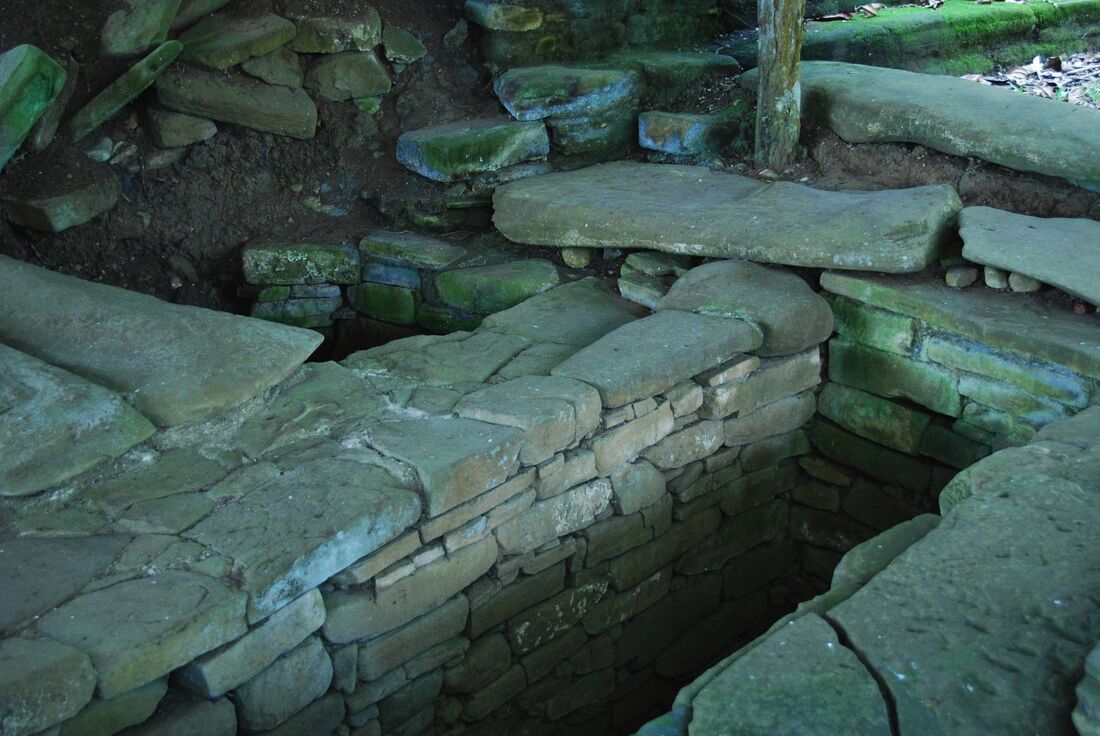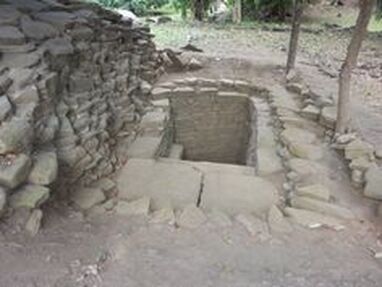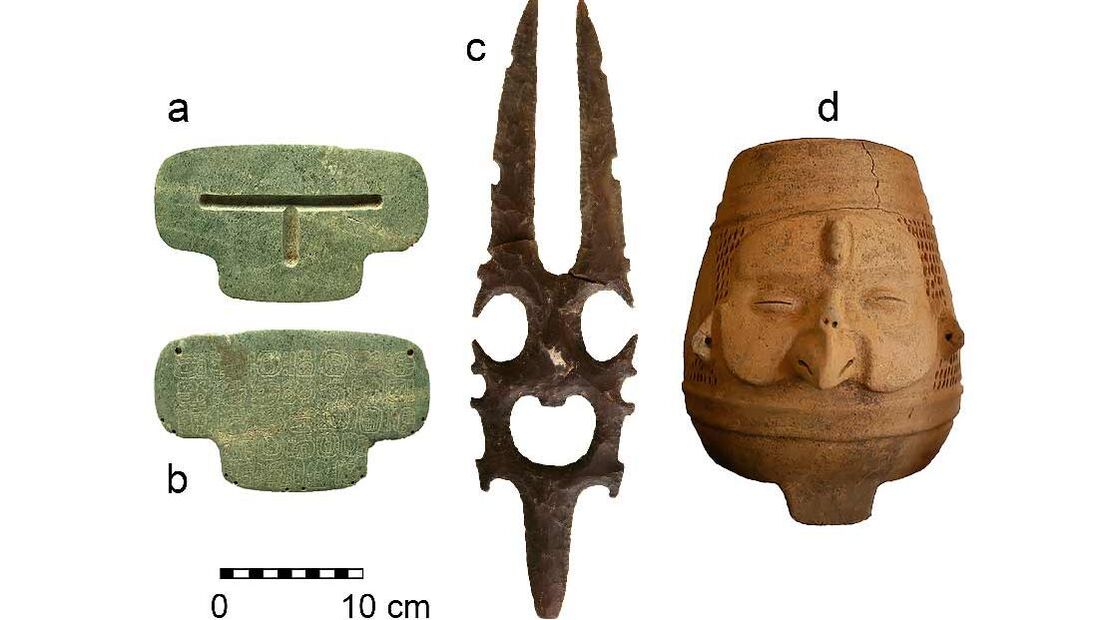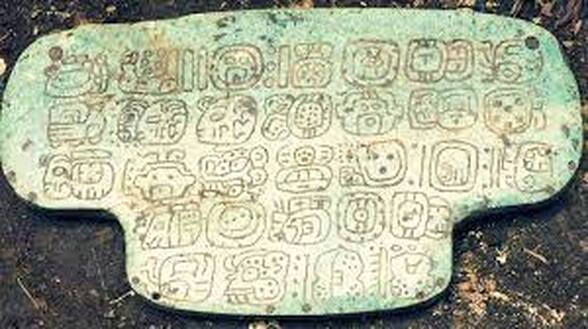Nim Li Punit Mayan Site
Nim Li Punit “The Big Hat” (121.32 Acres)
The name Nim Li Punit is derived from a carving on one of the site’s twenty six stelae, which depicts a figure wearing a large headdress. In the Maya Kekchi language, Nim li Punit means “the big hat.” The monument on which this carving appears is the longest stela in Belize (Stela 14), originally located in an area called Plaza of the Stelae.
Nim Li Punit is a small site in the Toledo District. It is situated on a ridge in the foothills of the Maya Mountains just off the Southern Highway, 25 miles north of Punta Gorda. Nim Li Punit is regarded as a ceremonial center consisting of two plazas, one higher than the other. There are 25 stelae of which 8 are carved. The largest structure is 33-40 feet above the plaza level and is constructed of dry, sandstone typical of sites in southern Belize. There are 3 plaza areas and a ballcourt. The concentration of so many stelae makes this a unique site.
The name Nim Li Punit is derived from a carving on one of the site’s twenty six stelae, which depicts a figure wearing a large headdress. In the Maya Kekchi language, Nim li Punit means “the big hat.” The monument on which this carving appears is the longest stela in Belize (Stela 14), originally located in an area called Plaza of the Stelae.
Nim Li Punit is a small site in the Toledo District. It is situated on a ridge in the foothills of the Maya Mountains just off the Southern Highway, 25 miles north of Punta Gorda. Nim Li Punit is regarded as a ceremonial center consisting of two plazas, one higher than the other. There are 25 stelae of which 8 are carved. The largest structure is 33-40 feet above the plaza level and is constructed of dry, sandstone typical of sites in southern Belize. There are 3 plaza areas and a ballcourt. The concentration of so many stelae makes this a unique site.
Archaeological Work
The site of Nim Li Punit first discovered in 1976 by oil prospectors in the area. Archaeological investigation began soon after by archaeologists including Dr. Jaime Awe, Dr. Norman Hammond, Barbra McLeod, Dr. Richard Leventhal and most recently, Dr. Geoffrey Braswell. Archaeological investigation at Nim Li Punit has discovered royal tombs, many stelae and in 2015 an impressively carved jade pectoral known as the wind jewel. More importantly, archaeological research has allowed us to understand how the people on Nim Li Punit lived and interacted with their environment and the surrounding cities.
The site of Nim Li Punit first discovered in 1976 by oil prospectors in the area. Archaeological investigation began soon after by archaeologists including Dr. Jaime Awe, Dr. Norman Hammond, Barbra McLeod, Dr. Richard Leventhal and most recently, Dr. Geoffrey Braswell. Archaeological investigation at Nim Li Punit has discovered royal tombs, many stelae and in 2015 an impressively carved jade pectoral known as the wind jewel. More importantly, archaeological research has allowed us to understand how the people on Nim Li Punit lived and interacted with their environment and the surrounding cities.
|
Directions
From Belmopan, take the Hummingbird Highway for 45 miles until you reach the Southern Highway Exit. Turn right onto the Southern Highway and travel an additional 50 miles (1 ½ hours) until you reach Indian Creek Village. Exit to the right on the gravel road and continue for about 1/2 mile until you reach the reserve. |
Opening Hours
365 days in the year from 8 am – 5:00pm Fees & Reservations
Belizeans: BZD$5.00 Non-Belizeans: BZD $10.00 Belizeans enter FREE on Sundays and Public and Bank Holidays, take along some form of ID. School and Government Groups need to contact the IA office for official Pass to visit this site. |
Nim Li Punit (/nim li puˈnit/) is a Maya archaeological site located in the Toledo District of Belize. Located 40 kilometres north of the town of Punta Gorda, at 16° 19' N, 88° 47' 60W. The site is near Belize's Southern Highway and is open to visitors subject to an admission charge. Nim Li Punit is sometimes known as Big Hat or Top Hat; the name is Kekchi Maya for "Big Hat", referring to the large elaborate head-dress found on a stela sculpture located at the site depicting one of the site's ancient kings.
Nim Li Punit is a medium-sized site from the Maya Classic Period, flourishing between the 5th & 8th centuries AD. The site consists of structures, located around three plazas, to include several step-pyramids, with the tallest being 12.2 meters high. The site has a number of large carved stelae (located in the visitors center), illustrating the ancient city's rulers. Several stelae's have been found in an unfinished state, suggesting possibly a sudden halt to the work.
Nim Li Punit is a medium-sized site from the Maya Classic Period, flourishing between the 5th & 8th centuries AD. The site consists of structures, located around three plazas, to include several step-pyramids, with the tallest being 12.2 meters high. The site has a number of large carved stelae (located in the visitors center), illustrating the ancient city's rulers. Several stelae's have been found in an unfinished state, suggesting possibly a sudden halt to the work.
Nim Li Punit is situated in the foothills of the Maya Mountains with proximity to clear mountain streams. The Maya Mountains form a nearly impenetrable backdrop forest to the north and east, while the expansive somewhat swampy coastal lowlands adjoining the Caribbean Sea lie to the east. Low-lying swampland between the Sarstoon and Temash Rivers is situated to the south. The site is within two kilometres of Belize's Southern Highway, accessed by an unpaved road. (The Southern Highway itself is paved in the vicinity of the site as well.) Local sand-stones are found in nearby stream and river beds, and these materials were used as the principal building stones for the site's structures and stelae. The Maya Mountains and foothills are among the oldest surface rock formations of Central America.
The ancient city of Nim Li Punit was laid out in a fashion consistent with other Mayan lowland Classic Era sites, such as Lubaantun, Pusilha and Uxbenka. Nim Li Punit was constructed during the Classic Period, using large amounts of fill material to achieve expansive level plazas and terraces. The arrangement of the major structures emulates the view of the Mayan cosmological world, setting the earth realm at the core. The burial structures are located on the northern edge of the site. The ball-court is specifically located intermediately to illustrate the perpetual conflict between the forces of life and death. The ball-court is so well preserved, it appears ready to host another game. It is thought that the Plaza of the Stela (located in the South Group), was used for astronomical observations. For example, there are several monuments present, situated long before the terrace known as Structure One, marked for the solstices and equinoxes. Dry-stone construction was used, and the stones are cemented with a Mayan mortar type substance.
There is a stela located at the site, with a ruler wearing a large head-dress or "Big Hat". The peak population for Nim Li Punit, in the Late Classic period was between 5,000 to 7,000 people. Early inhabitants, were probably from Guatemala. The peoples of Nim Li Punit are thought to have spoken a dialect of the Cholan language, a language spoken in the Mayan heartland. There is a carved stelae located at the site, which indicates that it was active between 721 to 790 AD. This is based upon inscriptions (on at least six stones), indicating Mayan calendar dates. As with many other Mayan sites, Nim Li Punit (in the 9th century), suddenly ceased to exist. There are many theories for this, over populations with the existing farmlands being unable to sustain the Mayan people, being one theory. The Nim Li Punit population is thought to have aligned with other Mayan settlements such as Tikal (in the Petén Basin region) of Guatemala.
Nim Li Punit is situated amidst a combination of rich, lush forest, soil, rock and other natural resources. These assets, coupled with the fact that the site sits next to a mountain stream, is what allowed the Maya site Nim Li Punit (and it's people), the resources needed for their civilization to thrive. The broadleft rainforest that surrounds Nim Li Punit, has secondary growth, composing of several biodiversity trees, herbs, mammals, birds, reptiles and other life forms. The soil is such, that it would support basic staple crops such as corn, beans and herbs used for medicinal purposes.
Mammals found in the area are numerous, they include:
Mammals found in the area are numerous, they include:
- Yucatán black howler monkey
- Alouatta pigra
- Central American spider monkey
- Ateles geoffroya
- paca
- Agouti paca
- Cougar Puma
- Jaguar
Discovery & Excavation
- 1976 - An open tomb was discovered at Nim Li PunitNim Li Punit in 1976 with initial explorations conducted by Norman Hammond of the British Museum-Cambridge University. Hammond produced the first site map and excavated a portion of the central plaza. Barbara McLeod of the University of Texas, then produced the first detailed analyses of the stelae inscriptions.
- 1983 - Richard Levanthal bored test pits and surveyed the site as part of an overall southern Belize Mayan mapping project.
- 1990's - Minor excavations were conducted by the Belize Department of Archaeology under the supervision of John Morris and Juan Luis Bonor.
- 2015 - Tomb excavations were conducted by the Toledo Regional Interaction Project directed by Geoffrey Braswell. This excavation unearthed numerous clay pots and a large jade pendant inscribed with Mayan hieroglyphs.
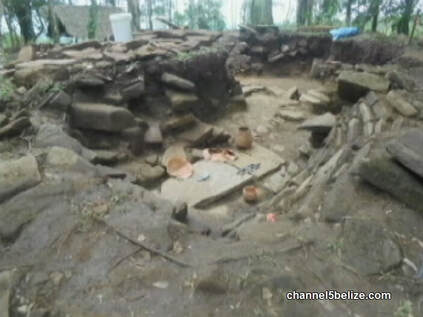
CHANNEL 5 NEWS - BELIZE
Friday, June 5th, 2015. BMG: The Nim Li Punit Archaeological site, located approximately 25 miles outside of Punta Gorda Town, has been the center of much hype in the archaeological world over the past few days.
It was about 12 days ago that archaeologists and researchers found 8 pieces of Jade and 26 ceramic pots buried in a tomb and they were amused by a magnificent Jade Pendant which has been named the second largest carved piece of Jade found in Belize and possibly the entire Mayan World.
One thing stood out to the archaeologists and that was the fact that many of the artifacts found at Nim Li Punit did not originate from any Maya City but from Mexico, including the remarkable jade pendant.
Dr. Geoffrey Braswell, one of the archaeologists that dug up the artifacts said: “Well it is significant in many ways, first of all its date, it’s really late, we didn’t expect to find a tomb so rich during the time period of the Maya collapse, so things were still pretty good here at Nim Li Punit, second I think we have to say the most important thing it is the second largest piece of carved Maya jade in Belize and maybe even in the Maya world I have to go look in Mexico and Guatemala and other parts but this is a very large piece.
It was brought here, it wasn’t made here, it was brought here from Caracol in the Cayo District by a Lord of Caracol who came here to what was a much smaller site to celebrate what was an important event on the calendar, an important almost like what was a century change on the calendar and to perform a sacrificial ritual, so the jade talks about him, his name was Janaab K’inich and he was the lord of Caracol, it talks about his mother whose name was the Holy Lady and she is even said it have 5 slaves and his father is mentioned and it says here that he came to do this ritual, Now what is interesting about that is that tells us that the Lords here had very powerful relations with Caracol, we did not know that before because there is no other way to tell from the artifacts here or from the other hieroglyphics – so he came from Caracol and made a visit, kind of like when Queen Elizabeth comes to Belize.”
The initial discovery of the artifacts was made by Maya Azarova, a first year graduate student who describe the event in an interview with the media, saying: “Maybe it was the 25th, it was like the end of the working day, everyone is already, but then I start cleaning, closing up the unit and then I see something, the earth is starting to fall inside and then like OMG! That must be whole pot and then I cry out and start to do it, then I cry out to Professor Braswell and say, hey have a look there is something here and he said it is 30 minutes until closing are you sure? And I’m like “yes I am totally sure.”
The Jade Pendant will be stored at the Central Bank and archaeologists say there is still a lot more to be found at Nim Li Punit.
Friday, June 5th, 2015. BMG: The Nim Li Punit Archaeological site, located approximately 25 miles outside of Punta Gorda Town, has been the center of much hype in the archaeological world over the past few days.
It was about 12 days ago that archaeologists and researchers found 8 pieces of Jade and 26 ceramic pots buried in a tomb and they were amused by a magnificent Jade Pendant which has been named the second largest carved piece of Jade found in Belize and possibly the entire Mayan World.
One thing stood out to the archaeologists and that was the fact that many of the artifacts found at Nim Li Punit did not originate from any Maya City but from Mexico, including the remarkable jade pendant.
Dr. Geoffrey Braswell, one of the archaeologists that dug up the artifacts said: “Well it is significant in many ways, first of all its date, it’s really late, we didn’t expect to find a tomb so rich during the time period of the Maya collapse, so things were still pretty good here at Nim Li Punit, second I think we have to say the most important thing it is the second largest piece of carved Maya jade in Belize and maybe even in the Maya world I have to go look in Mexico and Guatemala and other parts but this is a very large piece.
It was brought here, it wasn’t made here, it was brought here from Caracol in the Cayo District by a Lord of Caracol who came here to what was a much smaller site to celebrate what was an important event on the calendar, an important almost like what was a century change on the calendar and to perform a sacrificial ritual, so the jade talks about him, his name was Janaab K’inich and he was the lord of Caracol, it talks about his mother whose name was the Holy Lady and she is even said it have 5 slaves and his father is mentioned and it says here that he came to do this ritual, Now what is interesting about that is that tells us that the Lords here had very powerful relations with Caracol, we did not know that before because there is no other way to tell from the artifacts here or from the other hieroglyphics – so he came from Caracol and made a visit, kind of like when Queen Elizabeth comes to Belize.”
The initial discovery of the artifacts was made by Maya Azarova, a first year graduate student who describe the event in an interview with the media, saying: “Maybe it was the 25th, it was like the end of the working day, everyone is already, but then I start cleaning, closing up the unit and then I see something, the earth is starting to fall inside and then like OMG! That must be whole pot and then I cry out and start to do it, then I cry out to Professor Braswell and say, hey have a look there is something here and he said it is 30 minutes until closing are you sure? And I’m like “yes I am totally sure.”
The Jade Pendant will be stored at the Central Bank and archaeologists say there is still a lot more to be found at Nim Li Punit.
|
|
|
|
|
|
